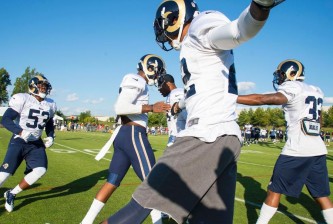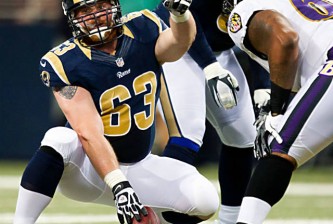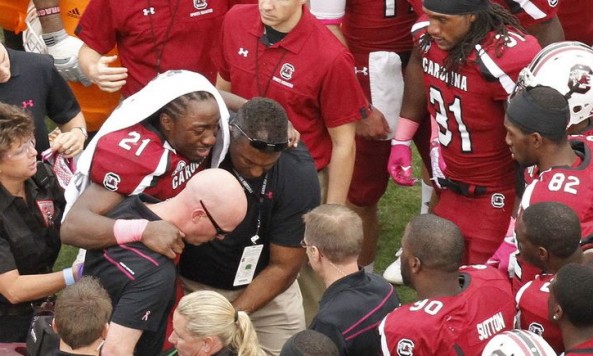Share
Veteran fantasy football drafters know about risk and reward. They know that waiting on a quarterback is a risk, as you let premier talents like Tom Brady and Drew Brees slip off the board. They know that drafting Peyton Manning, two years, one team change and at least four neck surgeries removed from his last NFL action, represented a huge risk, albeit one with potentially great rewards. Peyton's situation was unique, and there was little precedent to predict how many games he might play, or how well, before the ticking time bomb at the top of his spine went off.
Ultimately, though, there was a place where risk met reward, where Peyton's potential and pedigree overcame the fear of making a team-crippling pick. From March until September, that point was deep in the fifth round in an average 12-team fantasy draft, about 60 picks later than in his pre-injury days.
Fantasy drafters know the thrill and the fear associated with taking such a risk, with little more than pride on the line. What they don't know, and what NFL GMs have to deal with every April, is the weight of betting millions of your employer's dollars on taking (or not taking) a risk like that.
Which brings us to the Rams, and a high-risk, high-reward player like Marcus Lattimore. Lattimore was perhaps the best running back in the country when he had his left knee blown out in 2011. He had surgery and rehabbed it and came back in 2012, only to have his right knee destroyed in a game against Tennessee.
It was an even more severe injury, one that had coach Steve Spurrier offering public consolations like "Good things will happen for Marcus Lattimore. I don't know in what field of life, but … he's going to do well in whatever he does." Comparisons were made to the horrific injury suffered by high school quarterback Jacob Rainey. Irreparable arterial damage in Rainey's leg forced doctors to remove his leg above the knee.
Fortunately, Lattimore escaped the worst, and he decided to enter the NFL draft even though he might not play a down until 2014. And — putting Manti Te'o's all-too-public Rorshach test to one side — he represents one of the biggest risk-reward propositions in the draft. A potential franchise back available at a bargain price. Or potentially a guy who might never play a down of football again.
If you were Les Snead, would you take the risk? Here's what our panel of writers had to say.
Brennan Smith:
I think Lattimore is worth a risk, but only for the right price. Watching him healthy, he looked like the best running back in the nation with all-around skills that would help the Rams transition into the post-Jackson era.
However, his injury was also incredible gruesome, harkening back to Willis McGahee. Although the Bills still took McGahee high, the Rams should wait if they're interested in Lattimore until the fourth or fifth round.
Snead and Fisher have shown they aren't afraid to take a risk so I wouldn't be surprised if they took him, but he isn't worth a high pick with an exploded leg that will take at least a year to completely heal.
Tim Shields:
Absolutely, if they were to get him in the right round. Low risk, high reward. But he'd really have to check out medically. They'd have to feel confident with his progress and with his future. He would have been the first back off the board had he not been injured.
Michael Lasquero
Anywhere on Day 3 of the draft (rounds 4-7) is fine with me. You want to take guys who can be impact starters or can contribute on a consistent basis in the first three rounds. Guys in the later rounds are usually depth guys or project players.
One thing that concerns me about Marcus Lattimore's game is that he doesn't really have that quick burst. Against NFL D-lines, running lanes close much faster so you need backs that can hit the hole hard and fast.
Lattimore is the kind of guy though who can chug his legs and can at least move the pile and fall for a couple of yards. It's easy to see similarities between Lattimore and Steven Jackson and that could very much be why we shouldn't spend a high pick on Marcus. Jackson prides himself on taking care of his body to counteract the beating of his hard-nose running style. Given Lattimore's injury history, I don't think he has what it takes to be a dependable back.
If he's there on Day 3 and all our pressing needs are taken care off, I would welcome Lattimore into the fold. If he doesn't pan out, at least it sends out a memo to Pead and DRich to not slack or else you could be cut/benched.
Will Horton
I had an interesting conversation on Lattimore Monday with Joe Goodberry, a Bengals fan and draft writer for CincyJungle.com who's seen more than his share of injured running backs. He would not draft Lattimore, period. I disagree, I feel that there's a point where risk and reward meet, but he did offer an interesting bit of insight.
If you watch game tape on Lattimore from 2011, he's reminiscent of a young Steven Jackson – smooth and powerful, running explosively through contact. If you watch game tape on Lattimore from 2012, he's reminiscent of today's Steven Jackson: still a smart player, good blocker, good runner, but without the same burst. The same thing is true with Justin Hunter, the receiver in Tennessee who suffered an ACL injury in 2011. His 2012 game tape shows a big strong guy with a wide catch radius and fantastic hands, but just doesn't appear explosive.
Now, for normal athletes (i.e. not cyborgs like Adrian Peterson), it's supposed to take two years to fully recover from an ACL. In Hunter's case, that means his 2013 and beyond could actually be pretty bright. For Lattimore, though, I think we have to temper our expectations of his upside. Pre-injury, he might have been the first runner off the board. Post-injury, twice over, he just may be a different player.
I'd use a third rounder on a player like Hunter and hope for the best. For Lattimore, I think he'd slide well into day 3 for me.
What do you think? Let us know in the comments.
ShareRams Tickets























